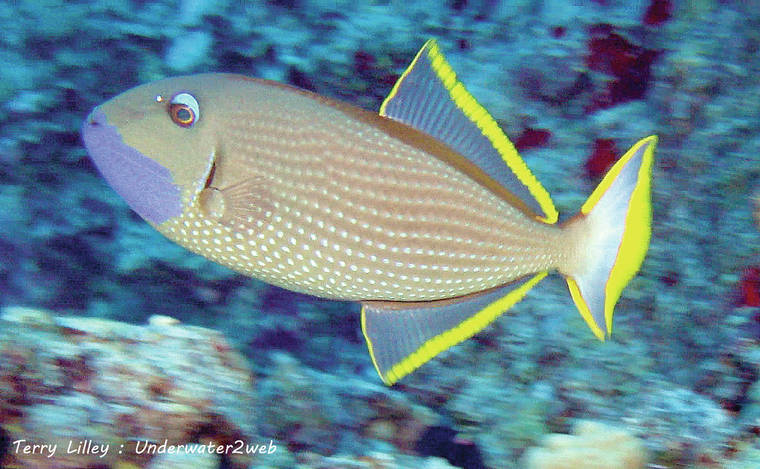Hawaiian triggerfish are made famous by our common, shallow-water, wedge-tail triggerfish, known as humumumunukunukuapua‘a, but we have other, less-known Hawaiian triggerfish that do not even have a Hawaiian name.
In old Hawai‘i, fishermen would spear or net fish in the shallow coastal waters, or use certain types of lures. They did not have scuba gear or dive masks to use, so some of the deeper-water species they never saw or even knew existed.
This is the case of the gilded trigger-fish that normally lives in waters below 50 feet deep on steep underwater cliffs where they blend into the deep blue of the sea. The common, wedge-tail trigger-fish live in shallow water, where they were often seen and speared for food. So they received a long Hawaiian name that describes their pattern, shape and behavior, whereas the colorful, gilded trigger-fish went undetected until recent times.
All of the trigger-fish have very unusual dorsal spines that lay flat on their back in a groove until erected and locked into place. When the fish senses danger it darts into a hole or crack in the reef and erects its spine, locking it in place so it cannot be pulled out backwards by a potential predator. The trigger-fish also has very tough skin and a pelvic girdle on its side that can be expanded to help wedge itself into its hiding place.
The gilded trigger-fish is normally a drab, blue-gray color, but during the breeding season the males become bright blue, gray and yellow, making them extremely beautiful. Over the past 50 years or so most scuba divers who saw them never knew how colorful the males were during breeding because the yellow colors do not show up very well underwater at depths of 80 to 100 feet so the fish just look solid blue-gray. In recent times us divers who shoot video or pictures have super-bright lights and cameras that can see better than the human eye, so we can capture the true, stunning colors of this fish species.
I was fortunate a few weeks ago to scuba dive the deep-water side of Molokini Island near Maui right in the middle of the breeding season for the gilded trigger-fish, and they were so busy chasing each other up and down the steep, underwater, 400-foot-tall cliffs that I could get close to them and shoot some beautiful video. Normally this fish would dive down into deep water if approached by a diver, so you could never get close enough for a good picture.
After seeing the colors on the male gilded trigger-fish, it showed me how important it is to identify fish species by their body and fin shape and not their color. Some of the scuba divers on the dive trip with me who did not have bright dive lights asked me “what was that gray fish species that were all chasing each other up and down the cliff?” while other divers with bright lights asked “what was that fish that had the beautiful blue head and yellow tail?”
You can see the Hawaiian trigger-fish in action in the movie “The World’s Guide to Hawaiian Reef Fish” at underwater2web.com, and also have your kids involved in our nonprofit Reef Guardians Coral Reef Kids Camp atreefguardianshawaii.org, where they can snorkel with the trigger-fish and see them in person
Aloha from under the surf.
•••
Terry Lilley, a marine
biologist, lives in Hanalei.
His websites include underwater-2web.com and gofundme.com/5urrm4zw.





